A Classic Car Road Trip through Normandy during the commemorations of the 70th anniversary of D-Day. A road trip through Normandy in a 1942 Ford GPW World War II Jeep. During our road trip along the coast of Normandy, we paid visits to several museums and memorials dedicated to the Allied invasion of Normandy in 1944 and the historic D-Day landing beaches, code-named Utah, Omaha, Gold, Juno and Sword. We also paid visits military war cemeteries containing the memorials and graves of soldiers who were killed during the many battles in Normandy, such as the Normandy American War Cemetery in Colleville-sur-Mer at Omaha Beach, and the largest Second World War military cemetery in Normandy, La Cambe German Military Cemetery near Bayeux. Numerous remains of the Atlantic Wall and the D-Day landings can still be seen along the entire coast of Normandy, such as the remains of the Mulberry Harbour on Gold Beach at Arromanches-les-Bains. The Atlantic Wall was a coastal defence system, built during the Second World War by nazi-Germany as a defence against the Western Allied invasion and liberation of Nazi-Germany occupied Europe. Each year, there are many commemorations and celebrations of D-Day. Second World War military vehicles owners are invited to attend several anniversary ceremonies of D-Day, our own 1942 Ford GPW Jeep stood on Juno Beach, in front of the famous Canada House in Bernières-sur-Mer during the 70th anniversary commemorations of the D-Day landings. We also participated in a memorial tour through Courseulle-sur-Mer.

Classic Car Road Trip Normandy: A road trip in a 1942 Ford GPW World War II Jeep along the coast of Normandy. We visited the historic D-Day beaches, the museums and memorials of the Western Allied invasion of Normandy in 1944. Our 1942 Ford Jeep on Utah Beach, the Utah Beach D-Day Museum is just visible in the background. Utah Beach was the codename for the westernmost landing beach of the five landing beaches in Normandy.
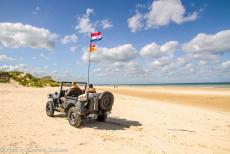
Classic Car Road Trip Normandy: A road trip in a 1942 Ford GPW World War II Jeep along the coast of Normandy. We visited the historic D-Day beaches, the museums and memorials of the Western Allied invasion of Normandy in 1944. Our 1942 Ford Jeep on Utah Beach, the Utah Beach D-Day Museum is just visible in the background. Utah Beach was the codename for the westernmost landing beach of the five landing beaches in Normandy.
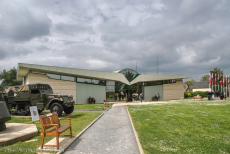
Classic Car Road Trip Normandy: The Pegasus Memorial Museum in Ranville has been designed to resemble a glider from the front, the museum houses numerous objects from the first action on D-Day, such as an airborne jeep, uniforms, equipment, photographs and a Rupert, one of the paradummies dropped over Normandy, the dummies were created to decieve the Nazi forces during the D-Day landings.
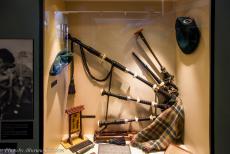
Classic Car Road Trip Normandy: One of the objects exhibited in the Pegasus Memorial Museum in Ranville is the bagpipe of Bill Millin, commonly known as Piper Bill or the Mad Piper. Bill Millin is best remembered for playing the bagpipes whilst under enemy fire during the D-Day landings. Bill Millin was the personal piper to Simon Fraser,15th Lord Lovat, commander of the 1st Special Service Brigade. Millin survived WWII. He became well-know from the 1962 film 'The Longest Day'.
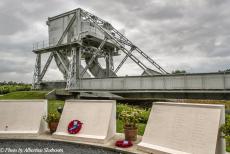
Classic Car Road Trip Normandy: The Veterans Charity Memorial and the original Pegasus Bridge are situated in the grounds of the Pegasus Memorial Museum in Ranville. The memorial is dedicated to the men of the 6th Airborne Division who landed at Ranville in the early hours of 6th June 1944, they captured intact two road bridges and liberated Ranville and Bénouville. Operation Deadstick was the codename for the operation to capture the two important bridges.
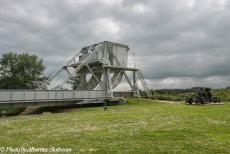
Classic Car Road Trip Normandy: The original Pegasus Bridge, on display in the Pegasus Memorial Museum in Ranville. In the early hours of D-Day, the 6th Airborne Division under the command of Major John Howard took the Bénouville Bridge across the Caen Canal within ten minutes. On the 26th of June 1944, the bridge was officially renamed the Pegasus Bridge, after the emblem of the British Airborne troops.

Classic Car Road Trip Normandy: A Scottish bagpipe and drum band on the Pegasus Bridge at Ranville as part of the 70th anniversary commemorations of D-Day. They paid tribute to Piper Bill Millin who landed on Sword Beach on D-Day and moved inland with the commando troops to relieve British paratroopers at the Pegasus Bridge. Bill Millin played the bagpipes when he crossed the Pegasus Bridge with the commando troops of Lord Lovat.
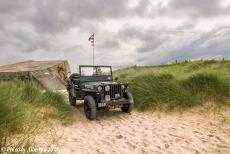
Classic Car Road Trip Normandy: Our own WWII Ford Jeep on Juno Beach, a German bunker of the Atlantic Wall in the background. Juno Beach is one of the five D-Day beaches in Normandy. Juno was the Allied code-name for a 7 km long landing zone on the coast of Normandy. Juno Beach is situated near the towns of Graye-sur-Mer, Courseulle-sur-Mer, Bernières-sur-Mer and Saint-Aubin-sur-Mer.
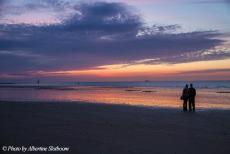
Classic Car Road Trip Normandy: Watching the sunset at Juno Beach, the evening before the 70th anniversary of D-Day. Now, Juno Beach is quiet and peaceful, but in June 1944 Canadian troops fought their way across Juno Beach. The Canadians suffered 5,500 casualties during the Allied invasion of Normandy. The first day of the invasion of Normandy, known as D-Day, 359 Canadian soldiers lost their lives on Juno Beach.
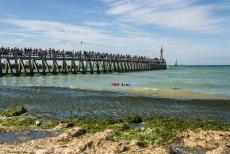
Classic Car Road Trip Normandy: Courseulles-sur-Mer, a floral wreath floating on the waves near Juno Beach Pier during a ceremony to commemorate the 70th Anniversary of D-Day. On D-Day, the largest amphibious invasion in history took place, 156,000 Allied troops landed on the coast of Normandy to liberate Western Europe from nazi-German occupation, 5,000 landing crafts and assault crafts, 289 escort vessels and 277 minesweepers took part in the operation.
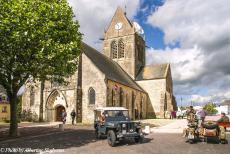
Classic Car Road Trip Normandy: Our own WWII Jeep in front of the Church of Sainte-Mère-Église, a copy of a paratrooper hanging from the tower. Sainte-Mère-Église is situated near Utah Beach. The village is known for the landings of the U.S. 82nd and 101st Airborne Divisions, who landed here on D-Day. Private John Steele landed on the church roof, his parachute got stuck on a pinnacle of the tower, he hung there helpless. Later, he was taken prisoner by the Germans.
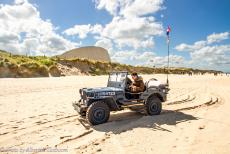
Classic Car Road Trip Normandy: Driving our own 1942 Ford GPW Jeep on Utah Beach, the Utah Beach D-Day Museum in the background. Utah Beach is the westermost beach of the five D-Day landing beaches of the Allied invasion in Normandy. Operation Overlord was the codename for the Allied invasion and liberation of Nazi-Germany occupied Europe. Operation Overlord started on D-Day, the 6th of june 1944.
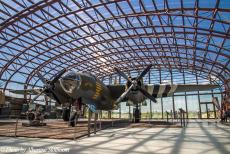
Classic Car Road Trip Normandy: A Martin B-26 Marauder, an American bomber aircraft used by Allied forces during WWII, on display at the Utah Beach D-Day Museum near Sainte-Marie-du-Mont. Over 5,000 Martin B-26 Marauders were built, only six of them still exist.The Utah Beach D-Day Museum is built on the beach where the first American troops landed on D-Day, the 6th of June 1944.
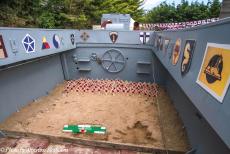
Classic Car Road Trip Normandy: Remembrance crosses with poppies, placed inside an Allied landing craft, the memorials to those soldiers who fought and died in combat during the Allied invasion in 1944. This Allied landing craft was used during the D-Day landings, it lies in front of Le Grand Bunker, the Atlantic Wall Museum in the village of Ouistreham, near Sword Beach, the codename for the easternmost beach of the five landing beaches in Normandy.

Classic Car Road Trip Normandy: Le Grand Bunker, the Atlantic Wall Museum in Ouistreham. The Atlantic Wall Museum is entirely dedicated to the construction of the Atlantic Wall. Nazi-Germany built the Atlantic Wall during WWII. The Atlantic Wall was a more than 5,000 km long defensive line, it stretched along the North Sea and Atlantic coast, from Norway to the French-Spanish border, it consisted of bomproof bunkers, coastal batteries and fortifications.
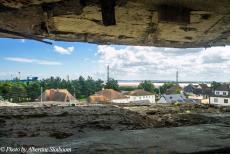
Classic Car Road Trip Normandy: View over the Ouistreham and Sword Beach from the top floor of the Grand Bunker, Le Grand Bunker. The bunker is situated in the village of Ouistreham and houses the Atlantic Wall Museum. Sword Beach was the easternmost landing area of D-Day. During the Second World War, the 17 meter high Grand Bunker was the German command post for a section of the Atlantic Wall along the Normandy Coast.

Classic Car Road Trip Normandy: The sick bay inside Le Grand Bunker, the Atlantic Wall Museum in Ouistreham. The interior of the bunker has been reconstructed down to the smallest details. The museum is entirely dedicated to the Atlantic Wall. There are numerous rooms such as a radio transmission room, a generator room, a dormitory, an ammunition store and observation post equipped with a range-finder, and objects concerning the construction of the Atlantic Wal.
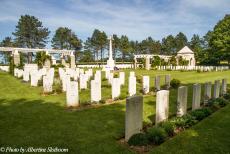
Classic Car Road Trip Normandy: Ryes War Cemetery at Bazenville. Bazenville is a small village about 8 km northeast of Bayeux and close to Arromanches-les-Bains. Ryes War Cemetery is situated in the Gold Beach sector, where the British 50th Division landed on D-Day. The first burials were on the 8th of June 1944. The cemetery contains 652 Commonwealth war graves, one Polish and 335 German graves. There are 67 unknown burials.

Classic Car Road Trip Normandy: Our own Ford Jeep in front of the Canada House in Bernières-sur-Mer during the celebrations of the 70th anniversary of D-Day. The iconic Canada House is situated on Juno Beach, where the Queen's Own Rifles of Canada landed on D-Day, June 6, 1944. It is probably the first house liberated by the Canadian troops who landed on Juno Beach. On D-Day, over 100 Canadian soldiers were killed or wouned in sight of this house.
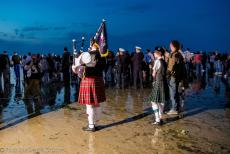
Classic Car Road Trip Normandy: A Scottish bagpiper on Juno Beach in front of the Canada House in Bernières-sur-Mer during the 70-year anniversary of D-Day. When the night fell, the bagpiper walked across the beach toward the sea followed by the guests and interested people. While he played his bagpipes, people threw flowers on Juno Beach as a tribute to the 340 Allied soldiers who were killed here 70 years ago on D-Day, the invasion of Normandy during WWII.
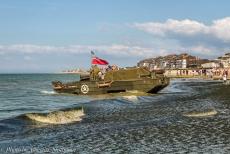
Classic Car Road Trip Normandy during the 70th anniversary of D-Day: A DUKW floating on the sea in front of Juno Beach at Courseulles-sur-Mer. In front of the beach, memorial wreaths were tossed overboard into the sea to remember the soldiers of the 3rd Canadian Infantry Division who were killed during the D-day landings on Juno Beach. During WWII, Juno was the Allied code name for one of the landing beaches along the coast of Normandy.
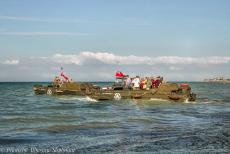
Classic Car Road Trip Normandy, the 70th anniversary of D-Day: DUKWs floating on sea within sight of Juno Beach at Courseulles-sur-Mer. A DUKW is a 2.5 ton six-wheel-drive amphibious vehicle, produced during WWII for the transportation of goods and troops over land and water, and for approaching coasts and crossing beaches in amphibious warfare. DUKWs were first used during the invasion of Sicily in 1943 and also during the Invasion in Normandy in 1944.

Classic Car Road Trip Normandy: La Cambe German Military Cemetery. On the 6th of June 2014, a memorial ceremony was held to mark the 70th anniversary of D-Day. La Cambe is the largest German military cemetery in Normandy. More than 21.222 German soldiers are buried at La Cambe. The cemetery has dark stone crosses and flat grave markers, there are two or three fallen soldiers buried in the same grave.

Classic Car Road Trip Normandy: Flowers on the grave of Michael Wittmann. Michael Wittmann was a German Waffen-SS officer, he was one of the most decorated tank commanders in WWII. He destroyed about 156 tanks, about 200 pieces of artillery and 300 small vehicles. Wittmann was killed in action on 8 August 1944. He and his tank crew were buried in an unmarked grave. Together with its crew, he was reintered on La Cambe German Military Cemetery in 1983.

Classic Car Road Trip: The Normandy American War Cemetery and Memorial at Omaha Beach in Colleville-sur-Mer is the largest WWII military cemetery in Normandy, it contains the graves of 9387 American soldiers who fell during the Battle of Normandy. The cemetery is situated on a high cliff overlooking the sea and Omaha Beach. Omaha Beach was the bloodiest of the D-Day landing beaches, U.S. divisions who fought on Omaha Beach lost about 2,400 men on D-Day.
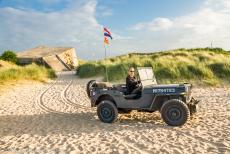
Classic Car Road Trip Normandy: During the Road Trip through Normandy in our own 1942 Ford GPW World War II Jeep, we also visited Juno Beach. On D-Day, the 6th of june 1944, Juno Beach was the landing zone of the 3rd Canadian Infantry Division and the 2nd Armoured Brigade. Our own jeep landed at Juno Beach in 1944, just a few weeks after D-Day, he served until the end of WWII and was left at Ypenburg Airport in the Netherlands.
